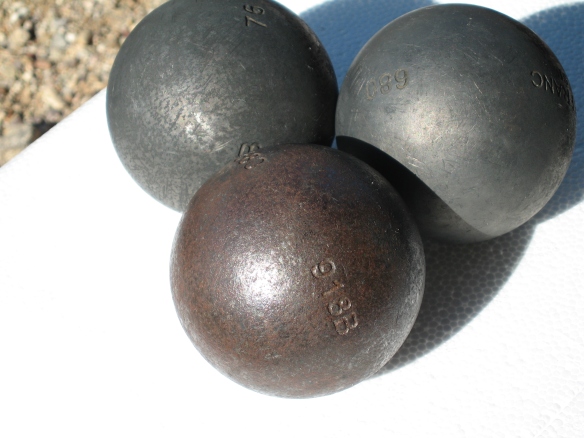For more tips, see the comments on our post about removing rust from your boules
Why blacken your boules? Perhaps you want to make it easier to tell your boules from other players’ boules. Perhaps you simply like the color.
Gun blacking wears off quickly. Black magic marker (permanent marker) leaves your boules slightly sticky. Kim Badcock, of the Mission Beach Petanque Club in Australia, has a better suggestion.
A soak or wipe-over with a very weak acid solution (vinegar, lemon juice, yellow mustard) will change the outer molecular layers of your boule to magnetite (“black rust”). Quickly wipe with an oiled cloth afterwards to help seal in the coloring.
This should work with all carbon-steel boules. It shouldn’t work with stainless steel boules or with chrome-plated boules (which means that it shouldn’t work with leisure boules).
Following Kim’s suggestion, I bought a jug of distilled white vinegar. I left two La Franc SB boules to soak in the vinegar overnight. (La Franc SB boules are relatively soft carbon-steel boules, acier au carbone.) In the morning they were really black. When I washed them off, a lot of black came off on my hands. The boules were left with a deep uniform matte gunmetal grey color. There was a small shiny spot where they had been sitting on the bottom of the container.
In this picture, the brownish boule in the front is a rusty boule that has been brought back from the dead. The two vinegar-blackened boules are at the back. The boule at the left has been played with more than the boule at the right, so it is more scratched-up. The image doesn’t really capture the color of the boules. The boules, while not absolutely black, are a much darker grey than they appear in the photo. In play, they do appear to be black.
Click to see larger image.

This picture was taken immediately after I treated the boules. The color was relatively long-lasting, but after about 5 months and about 50 hours of play, the boules began to look a bit shiny. So I blackened them again. Soaking them for 6 hours in distilled white vinegar restored them to the condition that you see in the pictures.




